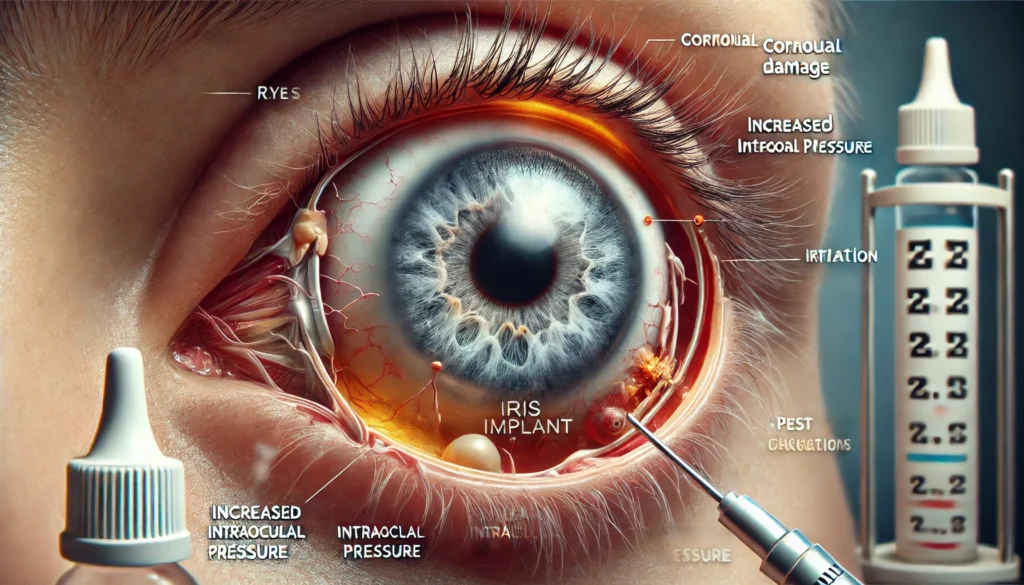Iris Implants: A Comprehensive Guide to Permanent Eye Color Change

- What Are Iris Implants?
- Complication Rates
- Types of Complications
- Required Surgical Interventions
- How the Procedure Works
- Why People Consider Iris Implants
- Risks and Complications of Iris Implant Surgery
- FDA and Regulatory Concerns
- Statistics and Key Data on Complications
- Alternatives to Iris Implants
- Conclusion: Is Iris Implant Surgery Right for You?
The Appeal of Permanent Eye Color Change
Eye color can be a defining feature of our appearance, and for many, the desire to change it permanently can be enticing. Iris implants offer a solution for those looking for a long-term change, but the procedure comes with serious risks. This guide will break down everything you need to know about iris implants—from the surgery process and its risks to recovery time and safer alternatives.
Whether you’re curious about the procedure for cosmetic reasons or have a medical condition requiring an iris implant, this article provides an in-depth exploration of what to expect.
What Are Iris Implants?
Iris implants are synthetic devices designed to either replace a damaged or missing iris or to change the color of your eye for cosmetic purposes. Originally developed for medical use, these implants are now being used to provide a permanent eye color change, despite not being FDA-approved for cosmetic use in the U.S.
Iris Implants for Eye Color Change: Risks and Complications
Complication Rates
Types of Complications
Required Surgical Interventions
Warning: The American Academy of Ophthalmology issued a warning in January 2024 about the risks of these surgeries. Iris implants were originally developed for medical purposes, not cosmetic use.
How the Procedure Works
- Surgery: A small incision is made in the cornea, and the synthetic iris is folded and inserted into the eye. The implant is positioned to cover or replace the natural iris.
- Duration: The surgery generally takes around 30 minutes per eye.
- Recovery: Most patients recover fully within 4 to 8 weeks, but complications can extend this timeline.
Why People Consider Iris Implants
There are both medical and cosmetic reasons to undergo iris implant surgery:

- Medical Use: Individuals suffering from aniridia, coloboma, or trauma-induced iris damage may benefit from iris implants to improve vision and eye appearance.
- Cosmetic Use: Some people choose this surgery for permanent eye color change, opting for a dramatic shift from brown to blue or green eyes.
Who Qualifies for Iris Implants?
- Medical Candidates: People with damaged or missing irises.
- Cosmetic Candidates: Individuals over 18 years old in good eye health.
- Pre-Surgery Considerations: Detailed consultation with an ophthalmologist is critical, as many eye specialists advise against the procedure due to risks, especially for cosmetic purposes.
Risks and Complications of Iris Implant Surgery
While the procedure may seem like a dream come true for those wanting to change their eye color, iris implants come with a significant set of risks that cannot be ignored. Below are the most common and severe complications associated with this surgery.

1. Glaucoma: The Silent Threat
Glaucoma is one of the most concerning complications of iris implants. The implant can disrupt the natural flow of fluid within the eye, increasing intraocular pressure, which in turn can damage the optic nerve and lead to vision loss.
- Key Stat: Studies show that 36% to 64% of patients with cosmetic iris implants develop severe vision issues, including glaucoma.
2. Corneal Damage
Corneal scarring or decompensation can occur as a result of the surgical incision. Damage to the cornea may result in permanent vision impairment, requiring further surgery or even corneal transplants.
3. Cataracts
Cataracts, or the clouding of the eye's natural lens, are a frequent complication after iris implant surgery. This may require additional surgical procedures to replace the lens, and in some cases, cataracts can worsen to the point of causing permanent vision loss.
4. Infection and Inflammation
Post-surgical infections or inflammation, such as iritis, can lead to further complications like blindness if untreated. These conditions are more common in patients who do not follow strict aftercare protocols.
How Long Does Eye Color Change Surgery Last? – An In-Depth Guide
FDA and Regulatory Concerns
The FDA has not approved iris implants for cosmetic purposes in the United States due to the significant risks involved. However, many individuals travel to countries like Mexico, India, and Turkey to have the procedure done. It's crucial to understand that the safety and regulatory standards in these countries may differ from those in the U.S., and patients should approach this decision with caution.

Patient Experiences: Real Stories
Many patients report mixed results. While some achieve the desired eye color change, many report long-term complications. For example, some patients have needed to have the implants removed due to glaucoma, severe pain, or vision deterioration.
Statistics and Key Data on Complications
Here are some critical real-world statistics related to the risks of cosmetic iris implants:
- Tasas de complicaciones: In one study, 9 out of 14 patients (64%) had to have their implants removed due to complications.
- In another case series, 24 eyes developed complications, with a median complication onset of 61.7 months after the implantation.

Types of Complications
- 45.8% of the eyes presented with iris abnormalities.
- 33.3% developed elevated intraocular pressure.
- 25% suffered corneal edema.
- 20.8% experienced intraocular inflammation.
- 16.7% developed cataracts.
Surgical Interventions Required
- 79.2% required cosmetic iris implant removal.
- 29.2% needed cataract extraction.
- 29.2% required corneal transplantation.
- 16.7% needed glaucoma surgery.
Alternatives to Iris Implants
For those who are hesitant about the risks of surgery, there are safer, less permanent alternatives to consider:
- Colored Contact Lenses: These provide a non-surgical, temporary way to change eye color. Lenses come in a variety of colors and patterns, offering flexibility without the risks of surgery.
- Laser Depigmentation: A newer, less invasive procedure that lightens brown eyes by removing melanin. While not without risks, laser depigmentation offers a reversible option with shorter recovery times compared to implants.
Alternatives to Eye Color Surgery: Temporary Methods

Comparison Table: Iris Implants vs. Colored Contacts vs. Laser Depigmentation (H3)
| Feature | Iris Implants | Colored Contacts | Laser Depigmentation |
|---|---|---|---|
| Permanence | Permanent | Temporary | Semi-Permanent |
| FDA-Approved | No | Yes | No |
| Cost | $8,000 - $10,000 | $200 - $1,500 per year | $5,000 - $7,000 |
| Risks | Glaucoma, cataracts | Infection (if not fitted properly) | Light sensitivity, uneven pigmentation |
| Recovery Time | 4 to 8 weeks | None | 1 to 2 weeks |
Laser Eye Color Change: How It Works
Conclusion: Is Iris Implant Surgery Right for You?
Iris implant surgery offers a permanent solution for those seeking to change their eye color, but it’s a decision that shouldn’t be made lightly. With significant risks like glaucoma, cataracts, and even potential vision loss, this procedure is not without its dangers. Before moving forward, consult with an experienced ophthalmologist and weigh the pros and cons carefully.
For those seeking a non-invasive option, colored contact lenses and laser depigmentation offer safer alternatives with fewer risks.
At EyeColorShift, we provide comprehensive resources and consultations to help you make the best decision for your eye health and appearance. Explore our website or schedule a consultation with our experts today to learn more about your options.
1. Is iris implant surgery safe for cosmetic purposes?
2. How much does iris implant surgery cost?
3. What are the risks and complications of iris implants?
4. How long does recovery from iris implant surgery take?
5. Are there any alternatives to iris implant surgery?
6. What follow-up care is required after iris implant surgery?
Call to Action:
"Looking to change your eye color safely? Explore your options at EyeColorShift and schedule a consultation today for personalized advice on achieving your desired look."

Leave a Reply